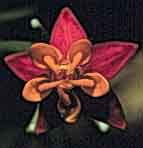
Asclepia cuarassavica L.
(Asclepiadaceae)
|
Asclepia cuarassavica L. (Asclepiadaceae) | |
Espinoza, R., Masís, A., Chavarria, F., Guadamuz, A. and Perez, D. 1998. Asclepia cuarassavica (Asclepiadaceae) Species Page, May 14, 1998. Species Home Pages, Area de Conservación Guanacaste, Costa Rica. http://www.acguanacaste.ac.cr
Herb 40-60 cm tall.
Flower:
The inflorescence is a terminal panicle of reddish-orange flowers. Usually there is nectar inside the corola.
|
Front view of the flower |
Fruit:
Errect folicles full of brown seeds with white fibers attached to them to aid in wind dispersion.
|
Mature open fruit |
Leaves:
The leaves are simple and opposite with a dentated margin. The petiole is channeled. White latex is secreted when a leaf or stem is broken.
|
Leaf arrangement |
Bark and wood:
The bark is beige.
Whole plant architecture:
View of the plant | |
Similar species:
Asclepias oentheroides has wide leaves and white flowers.
Asclepias woodsoniana has large slim leaves and white flowers.
Verification:
II.Geographic Distribution:
International:
In Costa Rica:
In the Area de Conservación Guanacaste:
In pastures and second growth forest on the dry side of the ACG. From sea level to 700 m (Espinoza, 1998).
Map of macro-habitats of the
ACG |
III. Natural History:
Very toxic. Causes problems in cattle when they ingested.
IV. How to find:
Can be seen in the old pastures and on the roadside, for example in the Santa Rosa and Centeno sectors.
Acknowledgments.
This project was carried out by the Area de Conservación Guanacaste/CR, with help from INBio/CR, ICBG from the Foggarty center, NIH/USA and NSF/USA.
Thanks to Kate Beattie for helping with the image management and translation of this species page.
Literature cited: